The Ultimate Guide to Passive Real Estate Investing
You go to work, you get your paycheck, and you carry on with your life. Your money doesn’t need to sit in a savings account to help you, though.
Are you on the fence over whether real estate or stocks are the better investment? If you’re looking for passive income, real estate may be the better option.
Read here for a breakdown of passive real estate investing and how to make it work for you.
What is Real Estate Investing?
First, let’s talk about the basics of real estate investing.
When most people buy a house, they intend to live in it and use it as a primary residence. They also might buy it as a vacation home they’ll use for certain times of the year.
Real estate investing, on the other hand, involves purchasing a property with the goal of earning an income.
While there are many types of real estate investing, the most basic form is when someone purchases a property which they then rent to a tenant.
The landlord is responsible for the mortgage, taxes, and other upkeep costs associated with the property. They pay these costs by charging rent of an equal amount. Once the owner pays off the mortgage, the rental income becomes pure profit.
Why Invest in Real Estate?
You may be wondering why investing in real estate is a good idea, given that real estate value can fluctuate.
While it is risky to invest in a property based on speculation of future value, property appreciation is a realistic expectation. Furthermore, if you leverage your capital and make use of mortgage interest deductions, the income you earn from real estate can be tax-free.
Plus, the tax write-offs you get from your property can lower your bill when tax day rolls around.
What is Passive Investing?
Now that you know a little about real estate investment, let’s talk about passive investment.
Passive investing is a strategy that aims to maximize future profits by minimizing buying and selling.
Rather than spending your time learning the ins and outs of your investment niche to make a profit, passive investment involves buying across a range of assets so that you benefit regardless of how the market fluctuates.
Passive investing is a long-game strategy designed to build wealth over an extended period of time.
What is Passive Real Estate Investing?
With all that in mind, what is passive real estate investing?
Essentially, it’s a way of diversifying your investment portfolio through real estate with an eye towards the long-term. It also involves little time commitment on your part, which can be a good thing for inexperienced investors.
Let’s say you decide to work with a company like High Return Real Estate. You’re putting your money into a few key investments and allowing it to grow over time. Your assets appreciate in value.
So you can keep living your life while your money grows. Sounds like a pretty good deal, right?
How to Earn Passive Real Estate Income
Of course, there’s an art to earning a passive income via real estate and rental properties.
Passive investing might be hands-off, but it helps to know what pies to have your fingers in. You don’t want to waste your time and money on a property that won’t earn back what you paid for it.
Create a Realistic Financial Model
It all starts with a realistic financial model.
This will tell you a number of important details about your potential investment. For example, it allows you to forecast the projected cash flow of the project (and thus what you’re likely to make on your investment).
The easiest way to do this is to itemize. You should account for income and expenses.
For example, most people think of rent as income. Income, however, also includes space for delinquencies, vacancies, and concessions. Expenses include all property management expenses and real estate taxes, repairs, utilities, insurance, maintenance, landscaping, and other related costs.
Determine Projected Cash Flow per Investment
Once you’ve broken down your income and expenses for an individual property, you need to determine your cash flow for each property. This is especially true if you have more than one or are planning to have more than one.
Don’t jump into the deep end yet–you need to do some research. Talk to other landlords and real estate brokers to get a sense of what their expenses and rental income look like.
If you’re investing in a condo or apartment, spend a lot of time looking at the marketing materials. It will give you a pretty good picture of the potential cash flow.
The goal here is to collect as much data as you can for a broad financial picture. Use as many houses and apartment buildings as you can get your hands on. From there, use that data to get one financial model representing an average.
This will give you an idea of what you can expect to earn, on average, from a single property.
Calculate How Many Units You Need
Once you know what you can earn on average from a single property, the final step is actually pretty simple.
If you know how much income you’d like to earn in a month or a year, divide that number by the cash flow per unit. Keep this formula in mind:
# of Units Needed = Desired Income / Predicted Cash Flow of One Unit
With this, you’ll know how many units you need to buy in order to have the income you desire. This will also give you an idea of how long it may take to invest in the desired number of properties, based on how much you can afford at the moment.
A Few Tips
Of course, passive real estate income doesn’t end with a bit of number crunching.
Here are four tips to make sure you maximize your investment.
Stay Out of the Slums
While it’s tempting to snatch properties for dirt cheap, buying properties in rough neighborhoods will only come back to bite you.
For starters, if the neighborhood isn’t good, you aren’t going to attract business, and you won’t attract the kind of quality tenants you want.
No matter how well you dress up a property, low-income housing will attract low-income tenants. These tenants statistically are more likely to cause you problems.
The neighborhood sets the standard for your property. If the rest of the neighborhood looks dingy, don’t count on tenants treating your property like Buckingham Palace. You also have to account for how often the property will be vacant–and in a rough neighborhood, that’s a good chunk of the year.
Side note: if you have some starry-eyed, charitable notions about investing in low-income housing, disabuse yourself of them. People will view you as a slumlord, and that’s not a valuable use of your time as a real estate investor.
Screen Your Tenants
On a related note, on a scale of one to Pentagon, screen the living daylights out of your tenants.
Yes, there are a lot of good people in the world with rough pasts. That said, the best tenants are the ones who pay their rent on time every month, and these tend to be the ones who have lived on the straight-and-narrow.
The best way to find these tenants is to get extreme in your screening process.
A credit check and a criminal background check are the bare minimum, but don’t stop here (even if you don’t see any red flags). You should run eviction history reports, ask for employment information, and call their supervisor to review the information provided and talk about what kind of employee they are.
Then talk to HR to confirm the income your potential tenant reported to you. If the number they gave and their actual number doesn’t match, don’t lease to them.
It may sound aggressive, but the truth is, if they’re willing to lie to you at the start of the process, they’ll be willing to lie as your tenant.
Stick to Long-Term Leases
Short term leases are an option, but can lead to problems long-term. If you’re in the game for passive income, your goal should be to avoid the expenses related to changing tenants as much as possible.
For that, you need to stick to long-term leases.
At a minimum, you should be leasing for a year. Two to three years is even better if you can swing it. The simplest way to convince tenants of this is to tell them that you raise rent by X amount each year. Let them know you’re willing to lock the rate for them if they agree to a longer lease.
Leave the short-term rentals to Airbnb.
Retention, Retention, Retention
Finally, if you want to keep your rental income passive, you should always aim to retain good tenants for as long as possible.
Think of your tenants as an investment as much as the property. Good tenants who don’t cause trouble, pay their rent on time, and take care of your property are exactly the kind of tenants you want to stay for several years.
Part of this is giving them a good experience by taking good care of the property, but it also means the little things. Make a note of their birthday and send a card, or ask about their kids, jobs, hobbies, or pets now and then.
It’s small, but it’s a message that you think of your tenants as people, and they’ll appreciate the extra effort.
More Ways to Work Your Money
There are so many ways to make your money do more for you beyond passive real estate investing. We want to help you reach your money goals.
Check out our blog for more tips on investing and money outside of work, like these ten tips on how to build wealth fast.



